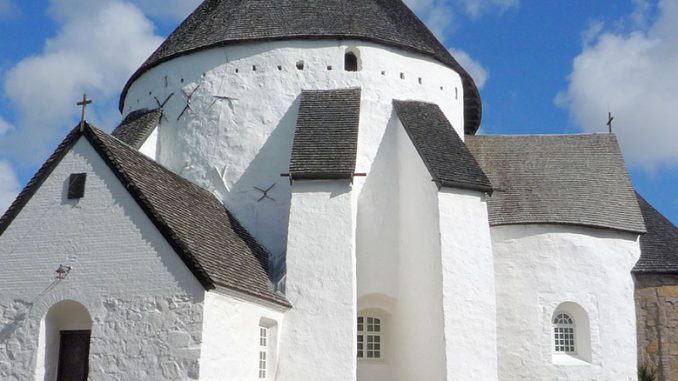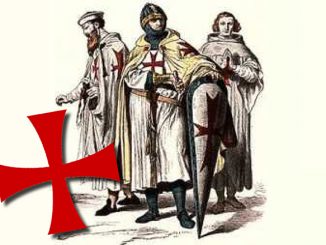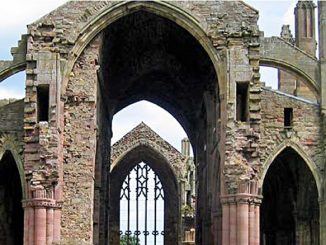
An Interview with Erling Haagensen co-author of The Templars’ Secret Island about the Templars and Bornholm.
THM: We understand that in addition to being a long time resident of Bornholm, the island of particular focus of your book, you are a journalist and documentary producer. Can you tell us about some of your previous work?
EH: One of my first documentaries was about the Lemmings. Lemmings have a strange behaviour. Approximately every fourth year they seem to commit collective suicide. Or so it was previously assumed. The Lemmings have an extremely high breading rate. Scientific research in Norway had revealed, in the late seventies, that their collective death is due to stress simply due to overpopulation. This puts the Lemming disaster in close connection with a possible future for the human race – which again might be the very reason for our strange, probably subconsciously, concern for the Lemming tale. I made this documentary in 1979 and it was later presented for an American audience by the Society for the Advancement of Scandinavian Study during a conference for Scandinavian Documentary-films in Washington in February 1999.
I have since made a large number of documentaries and TV-features, one of the most well known is “The Secret of the Templar’s,” which I produced and directed in close corporation with Henry Lincoln. This documentary in four parts was shown on Discovery Europe and Discovery US a large number of times over a five-year period.
Apart from my documentaries I have delivered TV-news from Bornholm to our national DR-TV over a period of 10 years.
THM: Everyone associated with books on the Knights Templar are familiar with the previous efforts of your co-author Henry Lincoln, most notably his two books with Michael Baigent and Richard Leigh, “The Holy Blood and the Holy Grail” and “The Messianic Legacy.” Can you tell us how you came to work with Henry?
EH: I think most people sometimes in their life have the feeling that some things are predetermined to happen. I did get that feeling in the case, when I first meet Henry. Prior to this, I had been working some five or six years on a discovery, that the medieval churches on my home island Bornholm were placed according to a complex, but incredible accurate, geometrical pattern. Naturally I had began to think about who could have been the master planner of this. It seems obvious it could not have been the local peasants. We know that the necessarily knowledge to make the measurements was present in cultures in the Eastern Mediterranean and the Middle East. Thus a natural question was – could there have been any situation, which put Bornholm in contact with the culture of this part of the world in the medieval time? Naturally I began to look at the crusading activities – and the mysteries of the Knight Templar were a logical thing to include in this research. I remembered the fascinating documentaries, Henry Lincoln had made about the mysteries in Rennes-le-Chateau, and in which the Knights Templar’s seemed to me to play and even maybe a more important role than previous thought. I made this simple assumption, that if the Knights Templar with their possible particular knowledge had something to the construction of the churches at Bornholm, they must have done something similar or at least be connected to something similar somewhere else. And I thought the most likely place to look for something similar would be in the area of Rennes-le-Chateau. I was about to write a book about my discovery and at the same time I was in negotiation with the Danish “TV2″ about a possible documentary on the Bornholm churches. So I called Henry and gave him my hypothesis and said, “if he looked at the churches in the area of Rennes-le-Chateau, he might find that they explored a similar geometrical pattern.”
He said, “Did you read my book?” I confirmed that I had, with great interest, read “The Holy Blood and The Holy Grail.” But he did not mean that book. Then it turned out that within the very week I called him, he had just published a book, “The Holy Place” in which he explains how the churches in the area of Rennes-le-Chateau are placed according to a geometrical pattern.
We simply had to meet. His book was to be published in France the following week, and I met him in Paris, where we had our first very long talk and compared the geometry. That was the beginning of a friendship and a cooperation, which now has lasted for 10 years and resulted in the TV-series “The Secret of the Templar’s” and the book “The Templar’s Secret Island.”
THM: Bornholm, the island that is the foundation of your research has been variously referred to as Burgunda, Burgunderland or Burgunderholm. We, at this magazine have always been aware of the connections between the Knights Templar and the region known as Burgundy. Do you see any connections between the region that was once called Burgundy and the island of Bornholm or is this merely a similarity in etymology?
EH: There is very good historical foundation for this connection. The Spanish / Roman history writer Paulus Orosius, who was writing at the beginning of the fifth century, explains how the Burgundians original homeland was the Island of Bornholm. He explained how they left the island and occupied the land north of the river Elbe – but were chased by King Attila and the Huns until they could settle at their present location in France. I do believe part of the Burgundy Royal Family still lived at Bornholm after that. We have a report from an English merchant, who reports to King Alfred shortly before the year 900 when he is passing the Danish islands of Sjælland , Lolland-Falster etc. And he says, “On Starboard we have Burgundaholm, and they have their own king.” The name Burgundia or Burgunderholm (holm means island) derives from the Burgundies. My personally theory is that the Burgundies are a particular tribe within the Goths. I believe Burgund derives from Burg – Goth. Burg means castle or stronghold, so I believe the Burgundians are Goths who were particular known for their castles.
THM: A central theme to this book, as well as your co-author’s previous works, seems to be in the positioning of Bornholm’s many churches according to sacred geometry, most notably the five pointed star. Why do you feel this pattern was of such importance to those who built the churches on the island?
EH: There is more than one reason for this. Geometry is basically what the word says: Measure of the Earth. Which means it forms the tool for producing maps. Then there is the symbolic and spiritual meaning. And then there is a specific scientific understanding, which has to do with an interaction between the material and the spiritual. But it will take to much space to go further in this interview.
THM: In our last issue of the magazine, summer 2002 Vol. 1 No. 4, we did a piece on the famed Round Church of the Templars at London. The churches of Bornholm seem to follow this pattern to the letter. Other than coincidence of design, what evidence is there to support the idea that the Templars were responsible for their construction?
EH: There is historical evidence that points at a plan, made between the Danish archbishops Eskil – a particular friend of Bernard of Clairvaux – and the Templar Grand Master Bertrand de Blanchefort about crusades in the Baltic. Eskil was in Bernard’s monastery Clairvaux from 1161 to 1167, and the plans seem to have been made around 1164. It seems that the plans compassed the Knights Templar being responsible for the supply to the crusading fleet. It involved thus the construction of a number of supply stores along the route of the crusading fleet from the harbor of Lobeck in the southwest of the Baltic to their final battlefield in Estonia 1000 kilometres further up in the Baltic Sea.
THM: Clearly Bornholm is not unique in the Baltic region for an abundance of medieval 12th century churches. In your researches have you encountered any churches of this design outside of Bornholm?
EH: Yes, there are a number of churches clearly made to the aim of being supply storages at the south coast of Scandia, at both sides of Kalmarsund – and there is a number of very interesting both round and squared constructions – so called Kastaler – on Gotland. All this should be compared to the crusading fleet and the master plan of the Knights Templar.
THM: There are many historians who contend that the round churches were not merely used for religious observances, but rather served a practical purpose as defensive fortresses. Do you have any thoughts on this theory?
EH: There is still at Bornholm a very strong believe, that the round churches were build as defence for the local population. But they cannot be. You just have to look at their position in the landscape. Two of them are placed in a completely flat landscape – the two others are built down a hillside. One of the most important means to create a defensive structure is the possibility for the defenders to make use of the heights – as you can see from the position of all medieval fortresses. There is no lack of topographical ideal spots everywhere on Bornholm for this purpose. That is why Bornholm also is known for its previous strongholds placed at inaccessible places away from the coast. If you compare the position of the churches with this fact, there is no way the round shape of the church could be made for defensive purposes.
THM: Much has been written in recent years about the treasure of the Knights Templar. Many have held the view that the Templars were not designed to protect Christian pilgrims in the early years following their formation in 1118, but rather were there to look for a hidden treasure buried beneath the Temple Mount. This idea is used to lend support to the question of why they did not admit nor seek new members for the first nine years. Do you support this idea?
EH: They said they were protecting the pilgrim roads to Jerusalem, and that was exactly what they did. Jerusalem has to be understood as the heavenly Jerusalem – and the pilgrim road to the heavenly Jerusalem is through the true understanding of Christianity. The Knights Templar did seek and did find documents supporting the true understanding of Christianity.
THM: Theories as to what may have been buried beneath the Temple Mount have ranged from such well known relics as the Ark of the Covenant and The Holy Grail to other notions such as the lost teachings of Christ and even His mummified and severed head. Do you have any theories as to what the Templars may have been looking for?
EH: Documents brought out of Egypt by Moses.
THM: Following the publication of your book in November of 2000, and under your initiative, geo-radar surveys were conducted at Østerlars church. What were the results of these surveys?
EH: Two independently investigations, one with a georadar and one with a gravimeter, both confirm that there is a vast underground structure beneath the church floor.
THM: We understand that similar surveys were recently conducted at Rennes-le-Chateau and a crypt has also been discovered beneath the church as well as the possibility of a chest or coffer beneath Sauniere’s Tour Magdala? In the book you lay out some interesting connections between Bornholm and Rennes-le-Chateau. Do you see a connection between the surveys conducted between these two regions?
EH: There might very well be a connection. First of all I hope to find a burial place. According to the traditions, we are dealing with, secrets are buried with the corpses.
THM: On behalf of our readers, I’d like to thank you for taking time out of your busy schedule for this interview. What are you working on now in terms of research? Can we expect a follow up book to The Templar’s Secret Island?
EH: We are planning a new book and a TV-documentary, where some of the things I have mentioned in this interview, will be further documented.
About Us
TemplarHistory.com was started in the fall of 1997 by Stephen Dafoe, a Canadian author who has written several books on the Templars and related subjects.
Read more from our Templar Reviews & Interviews Archives – Templar History



